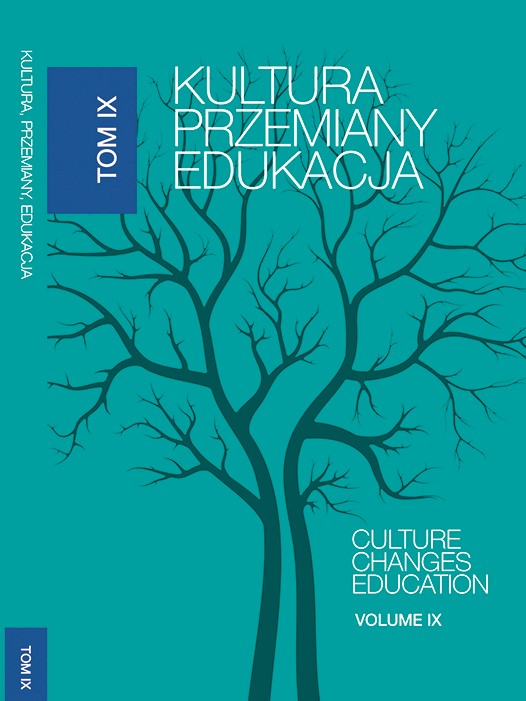Nowe technologie informacyjno-komunikacyjne i nowe potrzeby: kształcenie nauczycieli i obecność tych technologii w szkolnictwie wyższym
DOI:
https://doi.org/10.15584/kpe.2021.9.16Słowa kluczowe:
nowe technologie informacyjne (ICT), szkolnictwo wyższe, kompetencje cyfrowe, HiszpaniaAbstrakt
Włączenie nowych technologii informacyjnych (ICT) w obszar edukacji powoduje powstanie nowych alternatyw, nowych nawyków i nowych potrzeb. W przypadku nauczycieli ich zdolność do pracy i wykorzystywania urządzeń lub narzędzi technologicznych, które będą bardziej obecne w przyszłości, staje się istotna. W ostatnich latach pojawiły się takie możliwości, jak: grupowe otwarte kursy online (MOOC), otwarte zasoby edukacyjne (OER), gamifikacja, platformy do streamingu wideo oraz Google Classroom. Ich zastosowanie w procesie nauczania-uczenia się ujawniło się szczególnie mocno podczas pandemii spowodowanej przez SARS-CoV-2. Skutkuje to wymagającą i ciągłą refleksją nad przygotowaniem nauczyciela do jego pracy dydaktycznej dzisiaj i w przyszłości. Wszystko to dzieje się w kontekście szkolnictwa wyższego, etapu zawsze związanego z innowacjami technologicznymi i promującego badania w dziedzinie edukacji. Z tego powodu w niniejszym artykule w różnych jego częściach pokazano, jakie zaszły zmiany technologiczne i konceptualne dotyczące rozwoju i zastosowania ICT w klasie szkolnej. Jednocześnie analizuje się, dlaczego kształcenie nauczycieli w szkolnictwie wyższym jest problemem teraźniejszości i przyszłości.
Downloads
Bibliografia
Alberola, I.; Iglesias, M. & Lozano, I. (2021). Teachers’ beliefs about the rol of digital educational resources in educational practice: a qualitative study. Education Sciences, 11(5). doi: 10.3390/educsci11050239
Alkhalil, A.; Abdallah, M.; Alogali, A. & Aljaloud, A. (2021). Applying big data analytics in higher education: a systematic mapping study. International Journal of Information and Communication Technology Education, 17(3), 29-51. doi: 10.4018/IJICTE.20210701.oa3
Area, M. (2008). Una breve historia de las políticas de incoporación de las tecnologías digitales al sistema escolar en España. Quaderns digitals: Revista de Nuevas Tecnologías y Sociedad, 51.
Batanero, C.; De Marcos, L.; Rivera, L.; Holvikivi, J.; Hilera, J. & Tortosa, S. (2021). Improving accesibility in online education: comparative analysis of attitudes of blind and deaf students toward and adapted learning platforn. IEEE ACCESS, 9. doi: 10.1109/ACCESS.2021.3095041
Bian, F. & Wang, X. (2021). The effects of big data on the management of higher education in China its countermeasures. International Journal of Electrical Engineering Education. Doi: 10.1177/00207209211002076
Brown, M., McCormack, M., Reeves, J., Brooks, C., & Grajek, S. (2020). 2020 EDUCAUSE Horizon Report, Teaching and Learning Edition. Louisville, EE. UU.: Educause.
Carbonell, I. (2020). A new educational reality: TIC-TAC-TEP and neuroemotional Wifi curriculum planning. DIALOGICA, 17(3), 73-90.
Costa, R.; Medrano, M.; Ostáriz, P. & Moreno, A. J. (2021). How to teach pre-service teachers to make a didactic program? The collaborative learning associated with mobile devices. Sustainability, 12(9). doi: 10.3390/su12093755
Costa, R.; Ostáriz, P.; Medrano, M. & Moreno, A.J. (2021). Netiquette: ethic, education, and behaviour on Internet-a systematic literatura review. International Journal Of Environmental Research and Public Health, 18(3). doi: 10.3390/ijerph18031212
Cruz, M.; Pozo, M.; Juca, J. & Sanchez, L. (2020). The integration of ICT in the higher education curriculum in the last decade (period 2009-2019). Revista Ciencias Pedagógicas e Innovación, 8(1), 55-61. doi: 10.26423/rcpi.v8i1.368
Huang, X.; Zou, D.; Cheng, G.; Chen, X. & Xie, H. (2021). Trends, research issues and applications of artificial inteliggence in language education. Educational Technology & Society, 24(3), 238-255.
Instituto Nacional de Estadística (2021). Encuesta sobre equipamiento y uso de tecnologías de información y comunicación en los hogares. Retrieved from https://www.ine.es/dyngs/INEbase/es/operacion.htm?c=Estadistica_C&cid=1254736176741&menu=ultiDatos&idp=125473557669
INTEF. (2017). Marco Común de Competencia Digital Docente – Septiembre 2017. Retrieved from http://aprende.intef.es/sites/default/files/2018-05/2017_1020_Marco-Com%C3%BAn-de-Competencia-Digital-Docente.pdf
Jo, H.; Hwang, Y. & Dronina, Y. (2021). Mediating effects os Smartphone utilization between attitude and willingness to use home-based healthcare ICT among older adultrs. Healthcare Informatics Research, 27(2), 137-145. doi: 10.4258/hir.2021.27.2.137
Kim, J.; Pak, S. & Cho, Y. (The role of teachers’ social networks in ICT-based instruction. ASIA-Pacific Education Researcher. doi: 10.1007/s40299-020-00547-5
Lee, Y.; Malcein, L. & Kim, S. (2021). Information and communications technology (ICT) usage during COVID-19: motivating factors and implications. International Journal of Environmental Research and Public Health, 18(7). doi: 10.3390/ijerph18073571
Lorente, A.; Despujol, I. & Castaneda, L. (2021). MOOC as a leveling strategy in higher Education: the case of the Polytechnic University of Valencia. Campus Virtuales, 10(2), 9-25.
Lozano, R. (2011). De las TIC a las TAC: tecnologías del aprendizaje y del conocimiento. Anuario ThinkEPI, 1, 45-47.
Luca, M.; Mustea, L.; Taran, A.; Stefea, P. & Vatavu, S. (2021). Challenges on radical health redesign to reconfigure the level of e-health adoption in EU countries. Frontiers in Public Health, 9. doi: 10.3389/fpubh.2021.728287
Ma, W. (2021). Aritificial intelligence-based real-time communication and ai-multimedia services in higher education. Journal of Multiple-Valued Logic and Soft Computing, 36(1-3), 231-248.
Maaranen, K. & Kynaslahti, H. (2021). ‘It sounded like fun, that we would get to go to the univeristy’. Puils teaching ICT to peers: a case of study of Finnish Media Agents. Technology Pedagogy and Education, 30(2), 257-269. doi: 10.1080/1475939X.2021.1876756
Moreno, N.; Marin, A.; Cano, V.; Sanabria, J.; Jaramillo, A. & Ossa, J. (2021). Parental mediations and internet use by colombian children and adolescents. INTERDISCLIPLINARIA, 38(2), 275-290. doi: 10.16888/interd.2021.38.2.18
Nunez, P.; Larranaga, K.; Rangel, C. & Ortega, F. (2021). Critical analysis of the risks in the use of the internet and social networks in childhood and adolescence. Frontiers in Psychology, 12. doi: 10.3389/fpsyg.2021.683384
Nunez, Q.; Gomez, S.; Ganete, A. & Goncalves, D. (2021). Professional culture and ICT teacher education in times of crisis: the perception of teachers. Revista Electrónica Interuniversitaria de Formación del Profesorado, 24(2), 153-165. doi: 10.6018/reifop.470831
Perez, B. & Berbegal, J. (2020). The adaptability of the flipped classroom method: a case of study of its application during the coivd-19 crisis. REDU-Revista de Docencia Universitaria, 18(2), 49-66. doi: 10.4995/redu.2020.14419
Ricoy, M. & Martinez, S. (2021). Digital newspapers’ perspectives about adolescents’ Smartphone use. Sustainability, 13(9). doi: 10.3390/su13095316
Shukla, A.; Kushwah, P.; Jain, E. & Sharma, S. (2021). Role of ICT in emancipation of digital entrepeneurship among new generation women. Journal of Enterprising Communities-People and Places in the Global Economy, 15(1), 137-154. doi: 10.1108/JEC-04-2020-0071
Sysoieva, S. & Osadcha, K. (2020). Formation of the tutor ICT-competence in the procces of future teachers’ profesional training. Information Technologies and Learning Tools, 80(6), 207-221. doi: 10.33407/itlt.v80i6.4182
Yu, S. (2021). Application of artificial intelligence in physical education. International Journal of Electrical Enineering Education. doi: 10.1177/0020720921996604
Zhang, R.; Zhao, W. & Wang, Y. (2021). Big data analytics for intelligent online education. Journal of Intelligent & Fuzzy Systems, 40(2), 2815-2825. doi: 10.3233/JIFS-189322
Pobrania
Opublikowane
Jak cytować
Numer
Dział
Licencja
Prawa autorskie (c) 2021 KULTURA – PRZEMIANY – EDUKACJA

Utwór dostępny jest na licencji Creative Commons Uznanie autorstwa – Bez utworów zależnych 4.0 Międzynarodowe.


